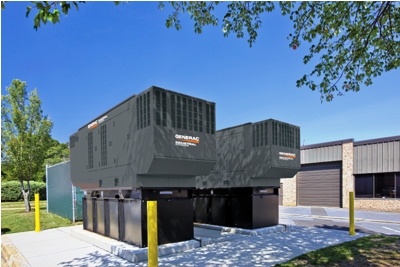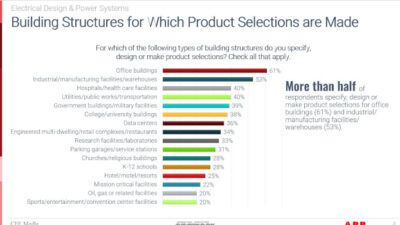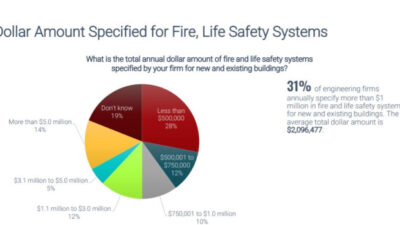Updated Special Report: Integrated parallel generators offer savings potential to the engineer.

Parallel power generation has always offered significant advantages to the standby power generation marketplace. It is more reliable than single engine generator solutions, with significant gains in reliability for critical loads. For example, if the reliability of a standby generator is defined at 98%, an N + 1 configuration has a reliability of 99.96% and an N + 2 configuration has a reliability of five nines. However, the implementation of these solutions has traditionally been limited to mission critical applications and large kilowatt projects. This is largely due to their cost, complexity, space requirements, and integration issues. To overcome these obstacles, various generator manufacturers are now offering more integrated solution
Challenging Tradition
In spite of the benefits of parallel power generation, a traditional approach could be cost-prohibitive. Historically, it was accomplished by using third-party vendors to integrate UL 891 dead-front panelboards into paralleling switchgear. To parallel two generators, which would typically require one section for each generator and a master control section, the cost would be approximately $70,000 to $90,000–just the start of the entire project’s expense. Additionally, control systems could be very complex. Each generator in the system would usually include four or five microcontrollers. These controllers would be a combination of analog and digital technology from various manufacturers hardwired together into an amalgamated system. As such, a two generator paralleling system with master control section would require nine to eleven controllers, including the speed governor, load-share controller, synchronizer, voltage regulator, generator controller, and protective relay. Space could be an issue, as well, since paralleling panelboards need dedicated floor space. Each section usually requires a space that is 36 in. wide, 48 in. deep, and 90 in. tall, as well as 36 in. in front and behind the switchgear cabinets. Finally, the entire installation process often takes about two weeks, with another two weeks for startup and commissioning–a process that requires the generator and switchgear technicians to be on site, and rarely goes smoothly.
More Integrated Control Solutions
The first step in creating an integrated approach to generator paralleling is to reduce application complexity by using one digital controller per generator to control all generator functions: speed governing, voltage regulation, generator alarm and monitoring, synchronizing, load sharing, and protection. This approach significantly enhances system performance. Inherently unstable load sharing methods are replaced with stable control loops. Synchronizing processes are greatly enhanced. Troubleshooting becomes a simple process of monitoring inputs and outputs using a laptop computer. Repairs that once took hours or days instead take only minutes using a spare on-site controller and a simple plug-and-play approach. An integrated paralleling system also needs a system controller for coordination (Figure 1). These functions include starting and stopping the generators, priority loading, load shedding, and data collection for supervisory control by building management systems. A significant improvement offered by this approach is that almost all communication to the system controller is digital. Also, the integrated system controller does not have to perform relay logic to sequence a combination of generator controllers. The end result is a design that is easy to install, easy to commission, and easy to repair.
Exploring the Capabilities
The next items to address in an integrated approach are the cost and space limitations of traditional implementations. Switching has been traditionally performed using an insulated-case stored energy breaker located within the panelboard. To reduce cost, some manufacturers are taking a streamlined approach that uses motor-operated breakers in a switch board to tie the generators together. This does remove some cost from the system. However, it still relies on breakers to perform repetitive switching operations, and still requires a cabinet dedicated to generator paralleling. Some companies have eliminated breakers by using a high-cycle-rated contactor specifically designed for switching power circuits as a paralleling switch. This switch is mounted and wired directly to the generator and cabled to a common point that is typically a generator distribution panel (Figure 2).
Application Strategies
There are a number of application strategies for integrated paralleling: One-line architectures: An integrated approach to paralleling could be arranged to work with a single automatic transfer switch (ATS) or multiple ATS configurations. In a single ATS application, the output from the generator’s paralleling switches could simply be cables to the generator lugs on the transfer switch. For multiple ATS configurations, the paralleling switches would be cabled to a distribution panel; the connection to the distribution panel could be main lug or through generator feeder breakers for additional isolation. Targeting single generator applications: Because a 3 x 500 kW integrated configuration can replace a single 1500 kW generator for no additional cost, parallel generation can be applied to situations dominated by large kW single-generator solutions. Such applications will have increased reliability; if one generator fails, 1000 kW of power will still be available. It also provides for scalability; the application could be sized for current needs, and additional generator capacity could be added when needed. The only thing that would require initial upsizing is the common point of generator connection (i.e. distribution panel, ATS, etc.). Smaller module sizes: Traditional generator paralleling solutions use large-capacity generators with a minimum unit count to reduce equipment costs. By using smaller generator module sizes, an integrated approach achieves redundancy with minimum additional capacity. Given the typical load factor and potentially some minimal load management, redundancy can be gained in most systems without any added capacity. For example, an application with a typical load of 800kW and a design maximum of 1400 kW can implement redundancy as 2 x 1500 in a 2N configuration. This application could also be served with 4 x 500 kW, achieving N+2 redundancy based on typical loads and N+1 at peak loading. It would also cost approximately $350,000 less and support unexpected future growth.
Summary
The benefits of parallel power generation are widely accepted in the marketplace. However, the implementation of these solutions has traditionally been limited due to their cost, complexity, space requirements, and integration issues. To meet the market’s expectations for price and performance, manufacturers are migrating to an integrated paralleling philosophy. With this technology, systems can be designed that compete effectively against single generator price points while maintaining the benefits of parallel generation. In addition, the technology lends itself to smaller generator module sizes, making it easier to achieve redundancy and scalability when implementing applications that previously used parallel generation, such as data and healthcare.
Kirchner is technical support manager for Generac Power Systems. He began his career in the electric power industry as a system engineer and project manager.
Example of Paralleling Benefits
Here is a real-life example of paralleling systems and savings:
Telecommunications Central Office
- Current typical operation load: 500 kW
- Current calculated dark-office peak load: 1000 kW
- Expected load growth of 250 kW (typical)/500 kW (dark-office)
Note: Dark-office peak load occurs when the batteries have been significantly discharged and full cooling is needed.
Solution Using 2N Approach:
- Two 1500 kW units, total capacity 3000 kW
- Typical initial load level – 17%,
- Typical final load level (after load growth) – 25%,
- Dark office load level (after load growth) – 50%
- Level of typical load redundancy – Needs + 1
- Estimated fully installed capital cost – $900,000
Solution Using Integrated Paralleled Generation:
- Three 500 kW units initially, total capacity 1500 kW
- Fourth 500 kW units added at time of load growth
- Typical initial load level – 30%,
- Typical final load level (after load growth) – 38%
- Dark office load level – 75%
- Level of typical load redundancy – Needs + 2
- Estimated fully installed capital cost – initial $500,000 + future $100,000



